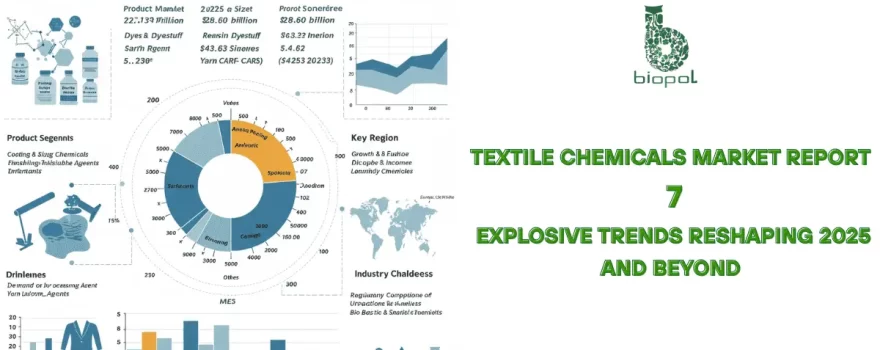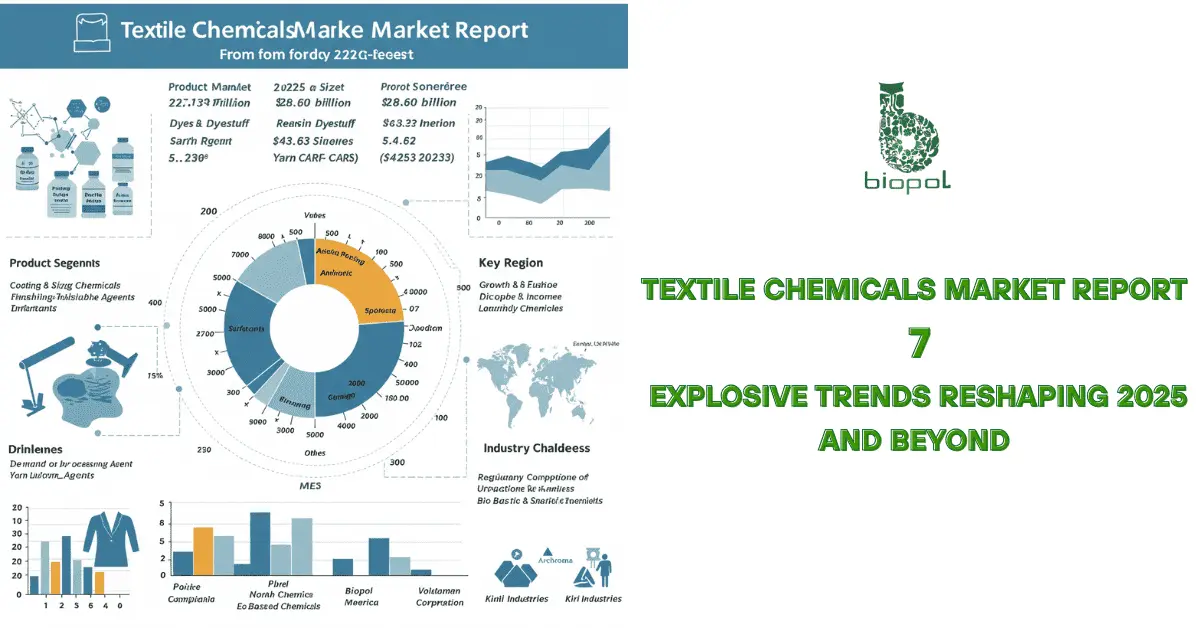
The textile chemicals market report unpacks the evolving dynamics of a $27 billion global industry, highlighting growth prospects, emerging technologies, and sustainability imperatives. As apparel demand and regulatory pressures rise, stakeholders must adapt to shifting supply chains, performance needs, and compliance landscapes. For informed decision-making, this guide offers crucial insights.
Table of Contents
Textile Chemicals Market Report
The textile chemicals market report offers a concise analysis of industry trends, market valuation, and growth outlook across key segments and regions. It focuses on chemical categories essential to textile production, including pre-treatment, dyeing, finishing, and specialty applications.
This report covers:
- Market size and projected CAGR
- Product segmentation by chemical function
- End-use industries (apparel, home textiles, industrial fabrics)
- Regional breakdown: Asia-Pacific, Europe, North America, others
- Key market drivers, challenges, and investment signals
The textile chemicals market report is relevant for manufacturers, suppliers, regulators, and investors. It prioritizes practical insights over raw data, helping stakeholders make informed, timely decisions in a competitive and compliance-driven market.
Market Size, Growth Rate, and Key Trends
The textile chemicals market report values the global market at USD 26.5 billion in 2021 and forecasts it will reach USD 38.9 billion by 2031, growing at a CAGR of 3.9% from 2022 to 2031. Growth is driven by demand for performance fabrics, sustainable processing, and expanding textile manufacturing in Asia-Pacific.
Key developments include:
- Rise in bio-based and low-impact chemical formulations
- Increased demand from technical textiles (medical, automotive, sportswear)
- Stricter global compliance standards affecting product design and sourcing
The textile chemicals market report highlights a shift from commodity volumes to specialized, value-added solutions—reshaping competition and investment strategies across the industry.
Demand Drivers and Industry Applications
The textile chemicals market report identifies rising consumer expectations, stricter regulations, and industrial diversification as core demand drivers. As end-users demand higher fabric performance and sustainability, manufacturers are turning to advanced chemical solutions to meet these targets without compromising efficiency.
Primary growth drivers include:
- Increased demand for technical textiles in healthcare, automotive, defense, and construction
- Rapid urbanization and income growth in developing economies fueling apparel and home textile consumption
- Environmental compliance requirements pushing adoption of low-impact, eco-certified chemicals
According to the textile chemicals market report, major applications span:
| Application | Chemical Functions Involved |
| Apparel | Dyes, softeners, antimicrobial agents |
| Home textiles | Flame retardants, wrinkle-resistance |
| Industrial fabrics | UV stabilizers, coatings, repellents |
| Medical textiles | Antibacterial and biocompatible treatments |
| Automotive interiors | Odor control, abrasion resistance |
The market’s center of gravity is shifting—from volume-based usage to performance-led application. Demand is no longer just about coloring fabrics—it’s about enabling textiles to do more, last longer, and meet global standards.
Competitive Landscape and Leading Companies
A recent market report on textile chemicals emphasizes the crucial role of key players in fostering both innovation and competition within the industry. Major companies focus on sustainability, technological advancements, and regional expansion to maintain leadership.
Top companies include:
- BASF: Leading with sustainable, eco-friendly solutions.
- Clariant: Strong in functional and specialty chemicals, focusing on performance fabrics.
- Dow Chemical: Innovating with biodegradable, water-efficient products.
- Huntsman Corporation: Specializing in textile finishing with a push towards green chemistry.
- Evonik Industries: Known for high-performance polymers in industrial textiles.
These players employ strategies such as:
- R&D investments in sustainable chemical solutions
- Expanding operations in Asia-Pacific and other emerging markets
- Acquiring smaller companies to broaden product portfolios
The textile chemicals market report shows that these companies are adapting to evolving demands, placing a premium on compliance, sustainability, and performance. Explore how leading players position themselves in the textile chemicals market and how it informs investment strategies.
Regional Outlook and Regulatory Landscape
The textile chemicals market report outlines regional growth and regulatory trends:
- Asia-Pacific leads in production and consumption, driven by countries like China and India, with strong growth in technical textiles.
- Europe and North America focus on strict environmental regulations, promoting sustainable, low-impact chemicals.
- Latin America and Middle East & Africa show moderate growth but face challenges with infrastructure and regulatory compliance.
The textile chemicals market report emphasizes the importance of adapting to local and global regulations, especially around sustainability, to remain competitive in all regions.
Investment Opportunities
The textile chemicals market report identifies key investment opportunities and strategic actions for firms and investors:
- Sustainability innovation: Focus on eco-friendly, biodegradable chemicals to meet growing environmental demands.
- Technical textiles: Invest in high-performance fabrics for sectors like healthcare, automotive, and defense.
- Emerging markets: Explore growth potential in Asia-Pacific and Latin America, where textile production is expanding.
Strategic takeaways:
- Prioritize sustainable product development.
- Invest in technology for smart and functional textiles.
- Target emerging markets for long-term growth.
- Stay proactive on regulatory compliance to ensure market access.
The textile chemicals market report highlights that aligning with sustainability trends and technological advancements will drive success in the evolving market.

